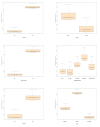A Machine Learning Approach for Investigating Delirium as a Multifactorial Syndrome
- PMID: 34281037
- PMCID: PMC8297073
- DOI: 10.3390/ijerph18137105
A Machine Learning Approach for Investigating Delirium as a Multifactorial Syndrome
Abstract
Delirium is a psycho-organic syndrome common in hospitalized patients, especially the elderly, and is associated with poor clinical outcomes. This study aims to identify the predictors that are mostly associated with the risk of delirium episodes using a machine learning technique (MLT). A random forest (RF) algorithm was used to evaluate the association between the subject's characteristics and the 4AT (the 4 A's test) score screening tool for delirium. RF algorithm was implemented using information based on demographic characteristics, comorbidities, drugs and procedures. Of the 78 patients enrolled in the study, 49 (63%) were at risk for delirium, 32 (41%) had at least one episode of delirium during the hospitalization (38% in orthopedics and 31% both in internal medicine and in the geriatric ward). The model explained 75.8% of the variability of the 4AT score with a root mean squared error of 3.29. Higher age, the presence of dementia, physical restraint, diabetes and a lower degree are the variables associated with an increase of the 4AT score. Random forest is a valid method for investigating the patients' characteristics associated with delirium onset also in small case-series. The use of this model may allow for early detection of delirium onset to plan the proper adjustment in healthcare assistance.
Keywords: aging; delirium; machine learning technique; nursing; random forest.
Conflict of interest statement
The authors declare no conflict of interest.
Figures




Similar articles
-
Diagnostic accuracy of the "4 A's Test" delirium screening tool for the postoperative cardiac surgery ward.J Thorac Cardiovasc Surg. 2023 Mar;165(3):1151-1160.e8. doi: 10.1016/j.jtcvs.2021.05.031. Epub 2021 Jun 1. J Thorac Cardiovasc Surg. 2023. PMID: 34243932
-
Development and Validation of an Electronic Health Record-Based Machine Learning Model to Estimate Delirium Risk in Newly Hospitalized Patients Without Known Cognitive Impairment.JAMA Netw Open. 2018 Aug 3;1(4):e181018. doi: 10.1001/jamanetworkopen.2018.1018. JAMA Netw Open. 2018. PMID: 30646095 Free PMC article.
-
Prediction of Incident Delirium Using a Random Forest classifier.J Med Syst. 2018 Nov 14;42(12):261. doi: 10.1007/s10916-018-1109-0. J Med Syst. 2018. PMID: 30430256
-
Diagnostic Test Accuracy of the 4AT for Delirium Detection: A Systematic Review and Meta-Analysis.Int J Environ Res Public Health. 2020 Oct 15;17(20):7515. doi: 10.3390/ijerph17207515. Int J Environ Res Public Health. 2020. PMID: 33076557 Free PMC article.
-
Delirium in hospitalized older adults.Hosp Pract (1995). 2020 Mar;48(sup1):3-16. doi: 10.1080/21548331.2019.1709359. Epub 2020 Jan 18. Hosp Pract (1995). 2020. PMID: 31874064 Review.
Cited by
-
The Role of Stress Hyperglycemia on Delirium Onset.J Clin Med. 2025 Jan 10;14(2):407. doi: 10.3390/jcm14020407. J Clin Med. 2025. PMID: 39860413 Free PMC article. Review.
-
Artificial Intelligence in the Intensive Care Unit: Current Evidence on an Inevitable Future Tool.Cureus. 2024 May 7;16(5):e59797. doi: 10.7759/cureus.59797. eCollection 2024 May. Cureus. 2024. PMID: 38846182 Free PMC article. Review.
-
Application of machine learning approaches in predicting clinical outcomes in older adults - a systematic review and meta-analysis.BMC Geriatr. 2023 Sep 14;23(1):561. doi: 10.1186/s12877-023-04246-w. BMC Geriatr. 2023. PMID: 37710210 Free PMC article.
-
Survival of Frail Elderly with Delirium.Int J Environ Res Public Health. 2022 Feb 16;19(4):2247. doi: 10.3390/ijerph19042247. Int J Environ Res Public Health. 2022. PMID: 35206439 Free PMC article.
References
-
- American Psychiatric Association . Diagnostic and Statistical Manual of Mental Disorders. 5th ed. American Psychiatric Association; Washington, DC, USA: 2013.
-
- Bellelli G., Morandi A., Di Santo S.G., Mazzone A., Cherubini A., Mossello E., Bo M., Bianchetti A., Rozzini R., Zanetti E., et al. “Delirium Day”: A Nationwide Point Prevalence Study of Delirium in Older Hospitalized Patients Using an Easy Standardized Diagnostic Tool. BMC Med. 2016;14:106. doi: 10.1186/s12916-016-0649-8. - DOI - PMC - PubMed
MeSH terms
LinkOut - more resources
Full Text Sources
Medical

